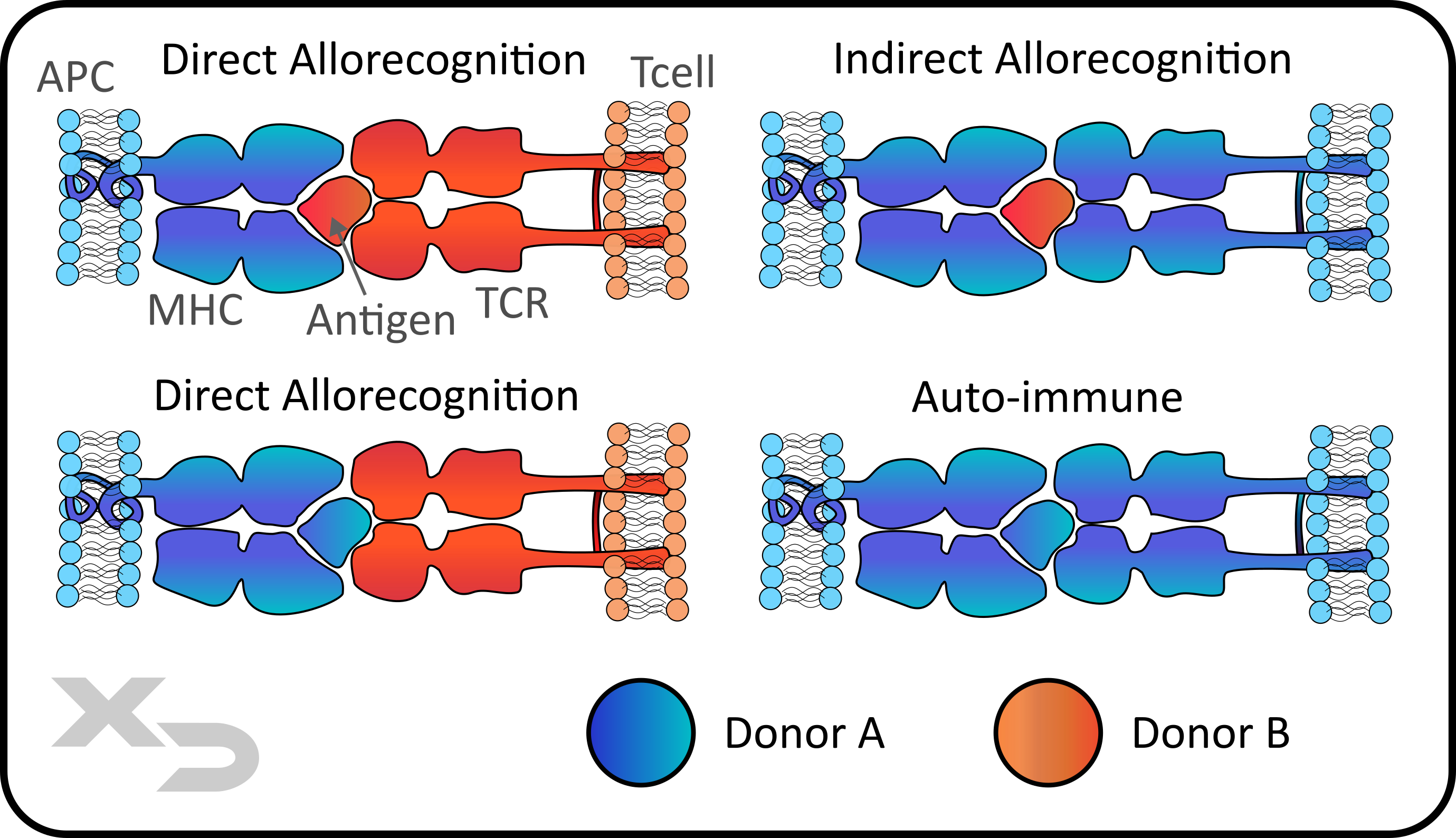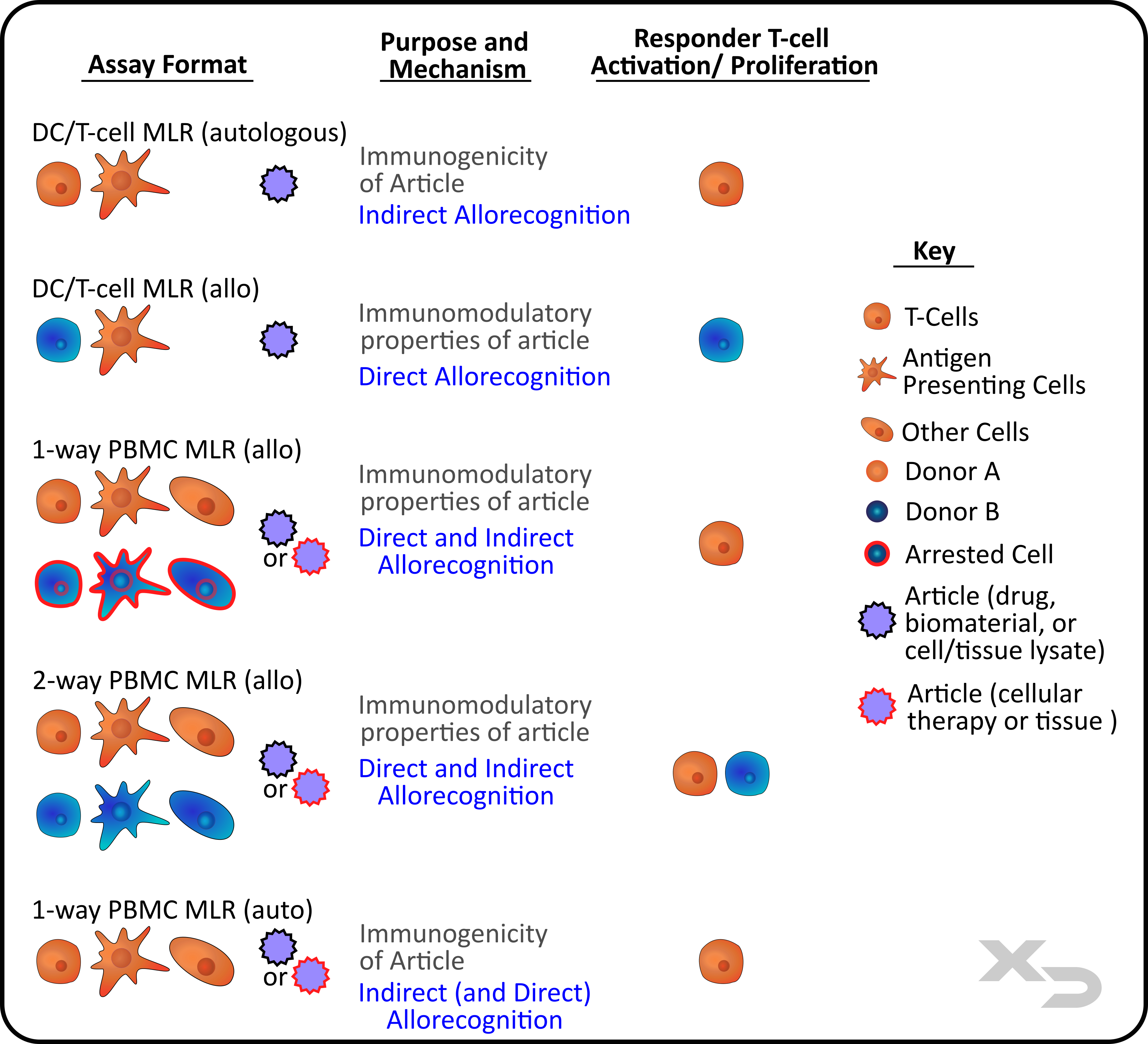What makes an MLR?
An MLR replicates an adaptive immune response via cell-mediated immunity, where a mixture of lymphocytes (T-cells, B-cells, and NK cells) are cultured with antigen presenting cells (APCs). The MLR is one of the single best in-vitro tools available to assess how these therapeutics affect our immune system.
But just as our immune system is complex, so too is the MLR. An MLR is not a single specific assay, rather it is a classification of an assay type used to investigate how therapeutics either cause or modulate cell-mediated immune responses. The figure below, shows several ways in which cell-mediated responses can occur (see our page on “what is an MLR” for additional details).

Figure: Methods of allorecognition (direct and indirect) as well as auto-immune.
Allogeneic: APCs and T-cells are from two different sources (donors)
Autologous: APCs and T-cells are from the same source (donor).
Xenogeneic: (variation of allogeneic) APCs and T-cells are from different species.
An MLR can be designed in a multitude of ways to replicate each one of these scenarios, and to evaluate a variety of different therapeutics; from small molecule drugs, antibody therapies, Cell and Gene Therapies (CGT), Human Cells, Tissues, and Cellular Based Tissue Products (HCT/Ps), implantable biomaterials, and more.
In addition to cell source (e.g. allogeneic and autologous), there are also differences in the cell types and treatments used. MLR’s can be performed with Peripheral Blood-derived Mononuclear Cells (PBMCs), which contain a mixture of lymphocytes (T-cells, B-cells, and NK cells) as well as dendritic cells (which act as antigen presenting cells) and monocytes (which are pre-cursors to dendritic cells).
Additional flexibility can be achieved by using immunomagnetic separations (or other separation technology). Specific cell subsets can be isolated or depleted from PBMCs. For example, the MLR can be performed with CD8 depleted T-cell populations, or Tregs can be isolated to observe their specific response. The most common application of this is isolating monocytes and differentiating them into Dendritic Cells (DCs) for culture with purified T-cells. Using purified cells provides a stronger reaction, in that the relative population of professional APCs and T-cells is much higher than in PBMCs alone. However, a purified reaction may be less indicative of in-situ conditions.
Another base variable of the MLR (besides optimization factors like concentrations, times, and readouts) is the treatment of T-cells to inhibit their reaction. In MLR reactions using PBMCs from two dissimilar sources (e.g. different donors) both sets of PBMCs have APCs and T-cells that can stimulate and react, respectively.
This is known as a two-way MLR, and is great for producing strong responses where both donors can stimulate and react to each other. However, depending on the readout technique used, this limits the ability to differentiate which responses came from which donor, and which donor had the stronger response (e.g. cannot differentiate secreted cytokines and colorimetric proliferation assays).
The solution for isolating a response to a single donor is to perform a one-way MLR, where PBMCs from one of the donors are treated (either chemically or irradiated) to arrest their functional ability, including T-cell activation. The treated APCs can still stimulate the other donor’s T-cells via direct allorecognition.

Figure: Types of MLR formats. Red outline indicates arrest of cellular response via irradiation or chemical treatment (e.g. mitomycin C).
The Mixed Lymphocyte Tumor Cell assay (MLTuC) is a variation of the canonical MLR, where autologous APCs and T-cells are cultured with tumor cells to assess anti-tumor activity. Check out our webpage on MLTuC to learn more.
T-cell proliferation assays are a broad category of many different assay types that involve T-cells, and as such the MLR falls under this umbrella. However, what differentiates the MLR from many other T-cell proliferation assays is the mechanism of action. In essence, a T-cell assay setup can be identical to the one-way PBMC MLR. However, in an MLR the reaction occurs due to a cell-mediated response (e.g. formation of MHC-TCR complex between APCs and T-cells), whereas in a T-cell assay the article (therapeutic) directly stimulates T-cells. Alternatively, stimuli can come from another source such as SEB or PHA, and then the therapeutic is added to modulate the reaction. In either case, the mechanism is not based in cell-mediated immunity. That said, these other T-cell proliferation assays are still highly useful and versatile for characterizing a therapeutic’s function and efficacy. Check out our pages on T-cell proliferation assays, and our services by cell type.
There is no “one-size fits all” format for the MLR, rather each factor such as cell type, source, and treatment needs to be carefully assessed and tailored to the individual therapeutic article and mechanism of action. This is in addition to the optimization of other factors like biologically relevant controls, optimal times and concentrations, and appropriate readouts (e.g. proliferation, activation markers, cytokines, phospho-flow, etc.). Xeno Diagnostics offers expert MLR, cell-based assay, and immunoassay services to help clients find which MLR format is best for them.
Briefly, the following list is a generalized organizational scheme for which MLR formats can be used, and for which applications:
Enhance your Development with a customized MLR
From evaluating mechanism of action to potency, and from immunogenicity to transplant tolerance, the MLR is a versatile platform that can be utilized for any therapeutics development pipeline. With many variations in format and readouts, the MLR can be custom tailored to fit your exact needs. Learn how the MLR can be leveraged to your benefit.
MLRs model an adaptive immune response
Want to know the immunological concepts behind the MLR? Checkout our webpage which discusses the minutia of cell-mediated immunity and how the MLR leverages those concepts to provide an informative assay.
Tailor MLR Readouts to Match your Needs
Decades of cell biology and immunological research have given us countless ways to measure and analyze a cellular response. At Xeno Diagnostics, we use every technique at our fingertips. Absorbance, fluorescence, luminescence; ELISAs, Flow Cytometry, PCR, and more. Cells are complex and can respond in a myriad of different ways, so it only makes sense that we employ multiple strategies to assess as much as possible. Our expert team can pair multiple readouts for data-rich results, or hone in on the most critical factors with single readouts. Whether it’s for lot release, potency, or mechanism of action – we can get you the results you need.
MLR Solutions For Industry Guidance
MLR is a powerful tool for immunological research and can be a critical asset in many drug development pipelines. From Discovery to Pre-Clinical and Clinical studies; no matter where you are in the process, Xeno Dx has an MLR service to help you!
"*" indicates required fields
Copyright © 2021. All rights reserved.